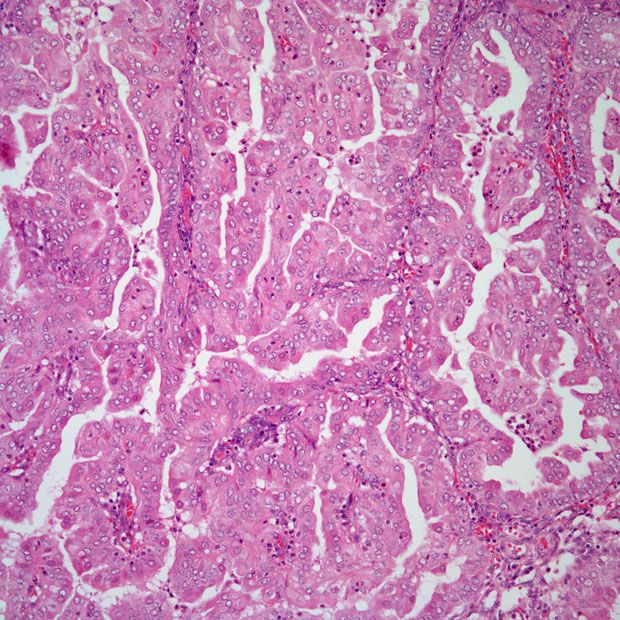Dostarlimab Combo Yields Significant PFS in dMMR/MSI-H Endometrial Cancer
The phase 3 RUBY trial of dostarlimab plus carboplatin and paclitaxel significantly improved progression-free survival in patients with dMMR/MSI-H or MMRp/MSS endometrial cancer.
Dostarlimab (Jemperli) plus carboplatin and paclitaxel had a statistically significant and clinically meaningful progression-free survival (PFS) and an early overall survival (OS) trend in patients with mismatch repair deficient (dMMR)/microsatellite instability-high (MSI-H) or mismatch repair proficient (MMRp)/microsatellite stable (MSS) endometrial cancer.
"Dostarlimab plus carboplatin/paclitaxel represents a new standard of care for patients with primary advanced or recurrent endometrial cancer,” according to an expert from University Hospital Denmark.

The results of the phase 3 ENGOT-EN6-NSGO/GOG-3031/RUBY trial (NCT03981796) were presented at the March European Society of Medical Oncology Plenary session. In patients who had dMMR/MSI-H endometrial cancer, the median PFS was not estimable (NE) in the dostarlimab group (95% CI, 11.8-NE) vs 7.7 months (95% CI, 5.6-9.7) in the placebo group (HR, 0.28; 95% CI, 0.162-0.495; P <.0001).
In the overall population, the median PFS was 11.8 months (95% CI, 9.6-17.1) in the dostarlimab group vs 7.9 months (95% CI, 7.6-9.5) in the placebo group (HR, 0.64; 95% CI, 0.507-0.800; P <.0001).
“Dostarlimab plus carboplatin/paclitaxel represents a new standard of care for patients with primary advanced or recurrent endometrial cancer,” Mansoor R. Mirza, MD, chief oncologist in the Department of Oncology at University Hospital Denmark and medical director of the Nordic Society of Gynecologic Oncology-Clinical Trial Unity, as well as lead author of the study.
Patients were randomized 1:1 to receive intravenous dostarlimab at 500 mg, carboplatin at 5 mg/mL/minute, and paclitaxel at 175 mg/m2 every 3 weeks for 6 cycles and then on to intravenous dostarlimab at 1000 mg every 6 weeks for up to 3 years. In the placebo arm patients were given matched treatment.
Overall, 494 patients were randomized to either dostarlimab plus chemotherapy followed by dostarlimab (n = 245) or placebo plus chemotherapy, followed by placebo (n = 249). In the end, 52 patients in the dostarlimab arm, and 36 in the placebo arm were still on study treatment.
Patients were eligible for treatment if they had histologically/cytologically proven advanced or recurrent endometrial cancer, stage III or IV or first recurrence with endometrial cancer, naïve to systemic therapy or systemic anticancer therapy with recurrent or progressive disease after 6 months, ECOG performance status of 0 or 1, and adequate organ function.
OS was also analyzed and reached 33% maturity in the overall population. In both the combination and placebo arms, it was NE (HR, 0.64; 95% CI, 0.464-0.870; P = .0021). Subsequent therapy was given in 34.5% of patients in the placebo arm and 15.5% in the dostarlimab arm.
For patients with dMMR/MSI-H endometrial cancer, it was also NE (HR, 0.30; 95% CI, 0.127-0.699). Subsequent therapy was given in 38.5% of patients in the placebo arm vs 15.1% in the dostarlimab arm.
In the MMRp/MSS population, the median PFS was 9.9 months (95% CI, 9.0-13.3) in the dostarlimab arm vs 7.9 months (95% CI, 7.6-9.8) in the placebo arm (HR, 0.76; 95% CI, 0.592-0.981). OS was not reached in the dostarlimab arm (95% CI, 29.8-NE) but was 29.8 months (95% CI, 21.9-NE) in the placebo arm (HR, 0.73; 95% CI, 0.515-1.024).
The objective response rate (ORR) was 77.6% (95% CI, 63.4%-88.2%) in the dostarlimab arm (n = 53), with a complete response (CR) of 30.6% and a partial response (PR) in 46.9% in the dostarlimab arm for patients with dMMR/MSI-H endometrial cancer. The placebo arm (n = 65) had an ORR of 60.9% (95% CI, 55.5%-80.5%), a CR of 20.7%, and a PR of 48.3%.
In the MMRp/MSS population, in the dostarlimab arm (n = 192), the ORR was 68.1% (95% CI, 60.4%-75.2%) with a CR of 23.3% and a PR of 44.8%. In the placebo arm (n = 184), the ORR was 63.4% (95% CI, 55.4%-70.8%) with a CR of 19.3% and a PR of 44.1%.
The subgroup analysis for PFS in the dMMR/MSI-H population saw a benefit in all patient characteristics, according to Mirza. However, additional data will be needed to confirm these results. When looking at the overall population, results were similar with a benefit observed when dostarlimab was added to combination therapy.
Grade 3 or higher treatment-emergent adverse effects (TEAEs) occurred in 70.5% of patients in the dostarlimab arm and 59.8% in the placebo arm, with serious TEAEs occurring in 37.8% vs 27.6%, respectively.
TEAEs that led to the discontinuation of either dostarlimab or the placebo occurred in 17.4% vs 9.3%, respectively, with the discontinuation of carboplatin occurring in 10.0% vs 7.7%, and the discontinuation of paclitaxel in 10.0% vs 9.3%.
TEAEs that led to death occurred in 2.1% of patients in the dostarlimab arm and 0% in the placebo arm. The median duration of treatment was 43.0 weeks in the dostarlimab arm vs 36.0 weeks in the placebo arm.
The most common grade 3 TEAEs in the dostarlimab arm were anemia, rash, and peripheral sensory neuropathy. In the placebo arm they were anemia, rash, and peripheral neuropathy.
Treatment-related immune-related AEs of grade 3 or higher included rash and alanine aminotransferase increase in both the dostarlimab and the placebo arms.
“Patient-reported outcomes showed that [treatment] did not negatively affect the outcomes by adding dostarlimab to chemotherapy,” concluded Mirza.
Reference
Mirza MR, Chase D, Slomovitz B, et al. Dostarlimab in combination with chemotherapy for the treatment of primary advanced or recurrent endometrial cancer: a placebo-controlled randomized phase 3 trial (ENGOT-EN6-NSGO/GOG-3031/RUBY). Presented at the March European Society of Medical Oncology Plenary Session; March 27, 2023.